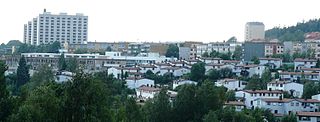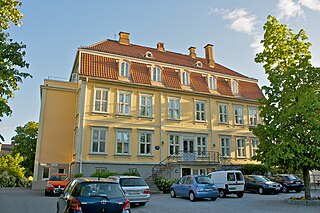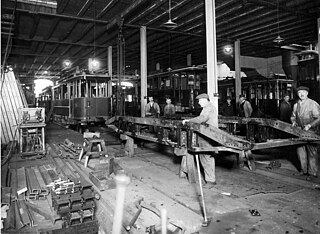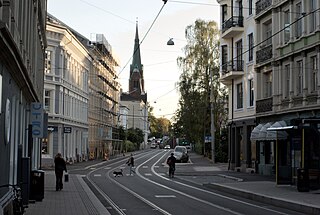
Ullern is a borough of the city of Oslo, Norway.

Grefsen is a neighbourhood in the city of Oslo, Norway.

Bøler is a south-eastern suburb of Oslo, Norway. It is one of the more picturesque areas of Oslo. Østmarka forest and lake Nøklevann are in its immediate vicinity. Infrastructure-wise, it has a shopping center, two elementary schools, a public bath, a library, a church and a stop on the Østensjøbanen metro line.

Birkelunden is a park placed centrally in the Grünerløkka borough of Oslo, Norway. It is formed as a rectangle, more or less like a city block.

Tåsen is a station on the Sognsvann Line of the Oslo Metro in Oslo, Norway. The station is located between Berg and Østhorn stations and is 6.8 kilometres (4.2 mi) from Stortinget. As one of the original stations on the line, Tåsen was opened on 10 October 1934. The station was moved 150 metres (490 ft) north in the 1990s, when the line was upgraded from light rail to rapid transit standard. In 1992, a deadly accident occurred when a T1300 train collided with a plowing car ahead of the station.

The Granfoss Tunnel is a set of two tunnels on Ring 3 in Oslo, Norway. The two tunnels are 2.1 kilometers (1.3 mi) long and they are part of the Granfoss Line, a 2.9-kilometer (1.8 mi) stretch of motorway which was opened in 1992 connecting Ring 3 with the European route E18. The name comes from the Granfossen waterfall on the Lysakerelva river, which passes nearby. The two tunnels run from Lysaker to Mustad, and from Mustad to Ullern Church, respectively.
Frognerkilen is a bay in the inner Oslofjord of Norway, east of the Bygdøy peninsula.

Linderud is a neighborhood in Bjerke borough, Oslo, Norway. The area originally formed part of the estate of Linderud Manor.

Olaf Ryes plass is a square and park placed centrally in the Grünerløkka borough of Oslo, Norway. It is more or less square in shape.

Schous plass is a square in the southern part of the borough of Grünerløkka in Oslo, Norway.

Elisenberg is a neighborhood in the Frogner borough in Oslo, Norway.

Bestum is a neighbourhood in Ullern in Oslo, Norway. Before the residential area arose, Bestum was mainly an agricultural area. The name origins from the Middle Ages. Bestum was served by a station named "Bestun" and the tram stop Bestum, but both are now closed. The residential houses in the area are drawn in Swiss chalet style.

Skillebekk is a neighbourhood of Oslo, Norway. It is located near Solli plass in the West End of Oslo, and is served by the station Skillebekk on the Skøyen Line. The name origins from Skillebekken, a brook between Bymarken and Frogner Hovedgård.
Karihaugen is a neighbourhood in the residential area of Ellingsrud in Oslo, Norway. The development of the area started in the 1970s.Karihaugen consists mainly of residential buildings in various shapes and sizes. Karihaugen also has a tiny industrial area, which borders to the much bigger Visperud industrial area in Lørenskog.

Homansbyen Depot, officially Kristiania Sporveisanlæg was an Oslo Tramway depot located at Sporveisgata 8 near Bislett in Oslo, Norway. It was constructed for Kristiania Sporveisselskab in 1874 and was the first tramway depot in the country. The facilities were designed by Henrik Thrap-Meyer and featured an administrative office, a horse stable, a forge, a workshop, a weighing shed, and a wagon depot. It had space for 28 horse wagons, 16 sleds, and 116 horses. The administrative office was built in brick and housed apartments, offices, and a laboratory for the veterinarian. The depot was reconstructed several times, and taken out of use in 1966. It was demolished three years later, and replaced with residential apartment blocks.
Rosenborg was a tram stop on the Oslo Tramway. It was located on the shopping street Bogstadveien, in the area of the same name in the neighbourhood Hegdehaugen. The station was preceded by Schultz' gate on the Briskeby Line and succeeded by Homansbyen and Uranienborgveien on the Homansby and Briskeby Line, respectively. In 2005, the station was upgraded, with heightened platforms, new skeds and real-time monitors. In 2014, the stop was closed and replaced by the newly established Bogstadveien stop, located a bit further north on the Bogstadveien street, closer to Majorstuen. The succeeding Uranienborg stop was relocated to the street junction between Bogstadveien and Josefines gate, and renamed Rosenborg.

Rosenborg, formerly Uranienborgveien is at tram stop on the Briskeby Line of the Oslo Tramway. It is located in Josefines gate, close to its street junction with Bogstadveien. It serves the neighborhoods Rosenborg, Hegdehaugen and Uranienborg in the West End of Oslo. The station is preceded and succeeded by Bogstadveien and Briskeby, respectively. The station used to be near the junction of Holtegata and Uranienborgveien streets, but it was moved towards Hegdehaugen and Rosenborg in 2009, after the line had been upgraded and reconstructed. In 2014, it was moved even further towards Rosenborg, and consequently renamed. In the same move, the former Rosenborg stop was replaced with the newly established Bogstadveien stop, situated further north, closer to Majorstuen.
Jomfrubråten is a residential area of Nordstrand in Oslo, Norway. It is located approximately 3 kilometres (1.9 mi) away from the city centre. The area was disintegrated from Ekeberg in 1920, and made a residential area when the Ekeberg Line opened in 1917. A station with the same name serves the area on the Ekeberg Line, and formerly on the Simensbråten Line, but the latter line was closed in 1967.

Bogstadveien is a street in the district of Frogner in Oslo, Norway. It is considered a central business district and features many of the city's wide range of exclusive shops as well as entertainment, hotels and restaurants. The road is known for the frequent Farmer's Markets on weekends as well as its biannual car-free shopping events.

The German School of Oslo is a German-language school in Oslo, Norway and is led by Oliver Schaefer. It is located in Sporveisgata 20 at Bislett, and was opened in 1980. In the beginning, the school was located in the basement of the German Protestant Community of Oslo in Eilert Sundts gate 37, before it moved to Majorstuen School. In 1998, the DSO moved from Majorstuen to the disused Hegdehaugen Upper Secondary School, where it has been ever since.
















